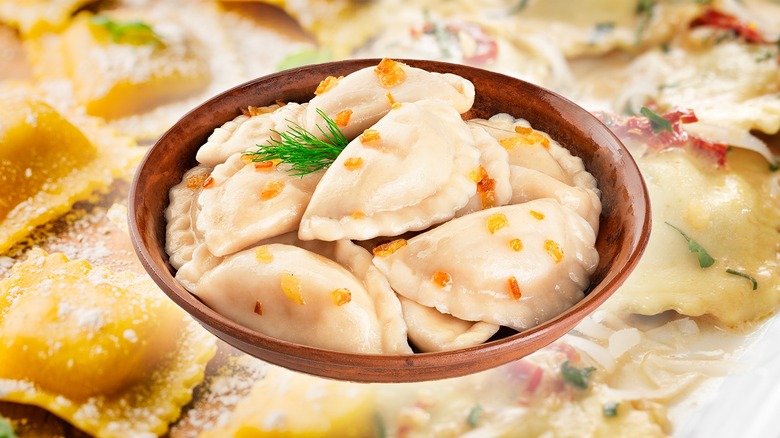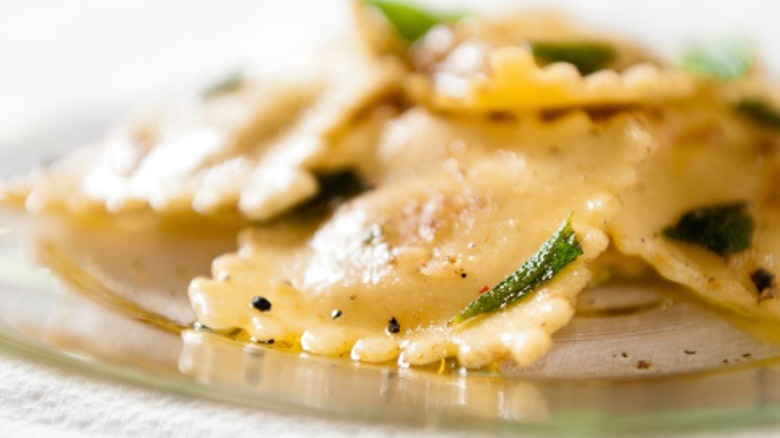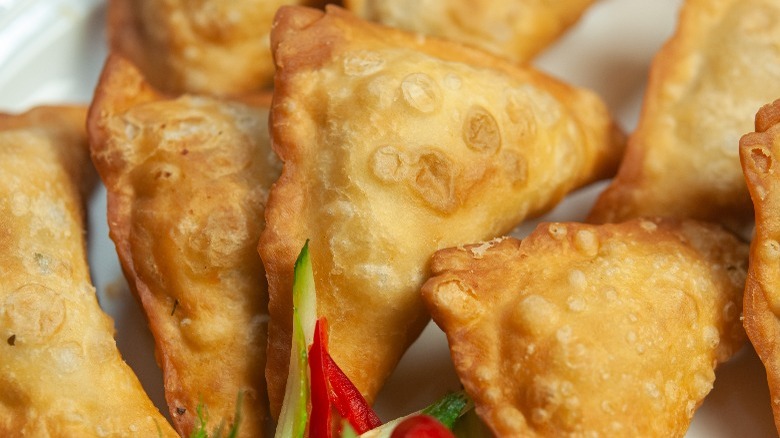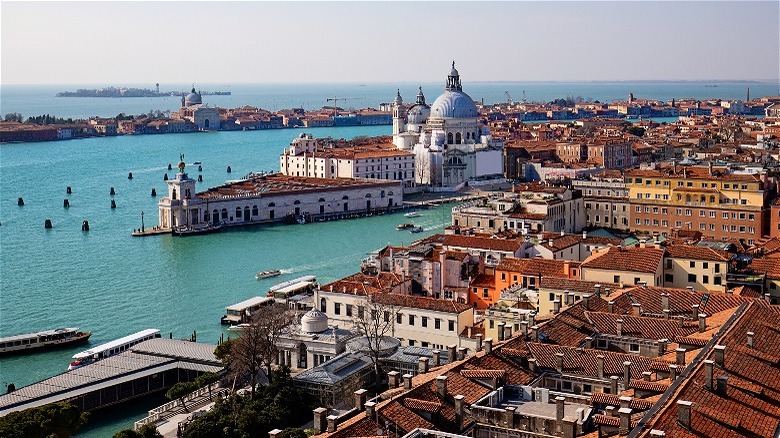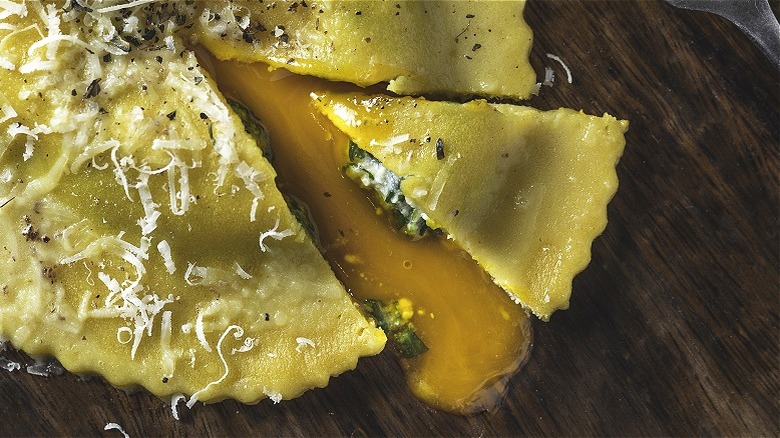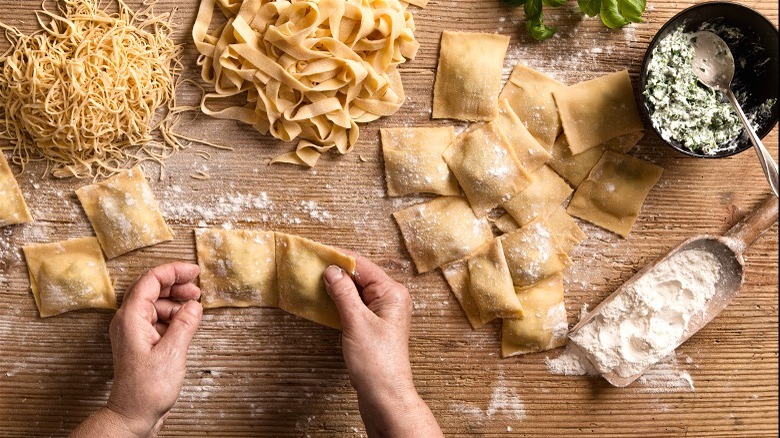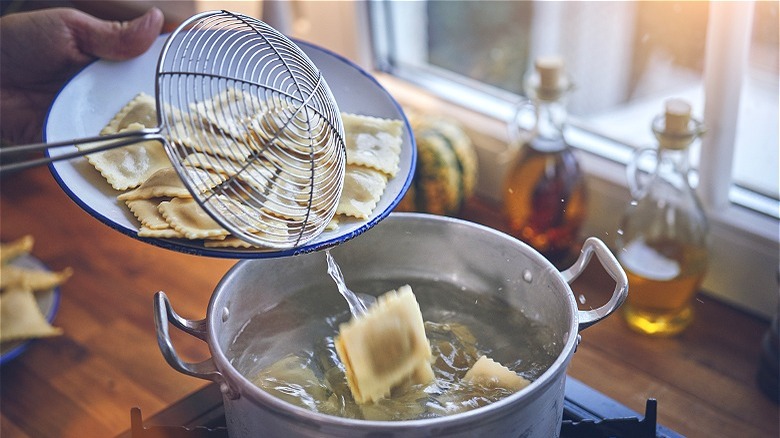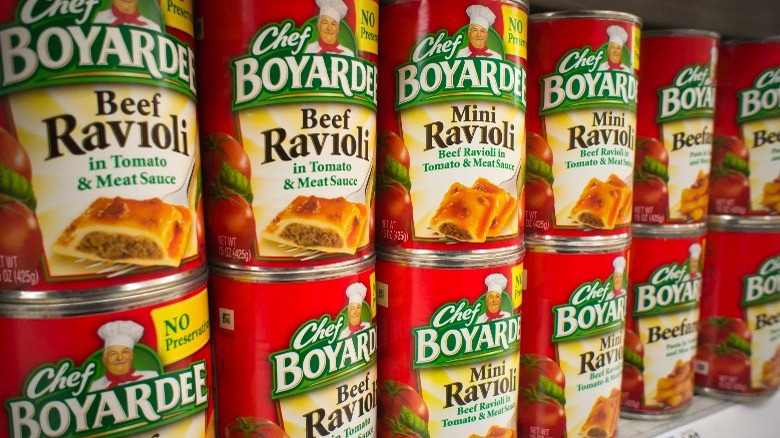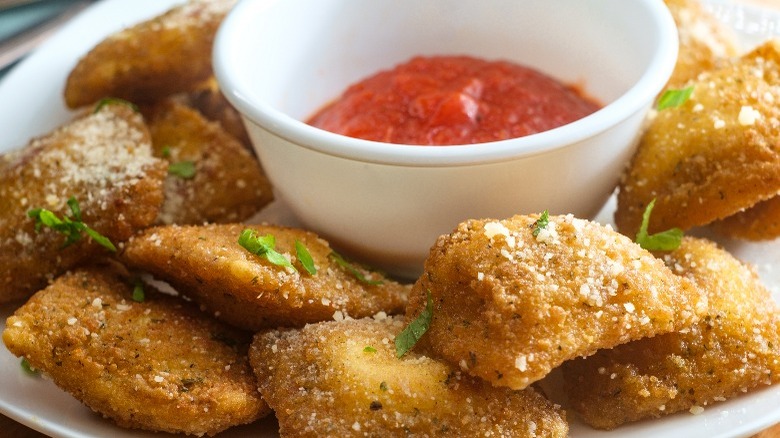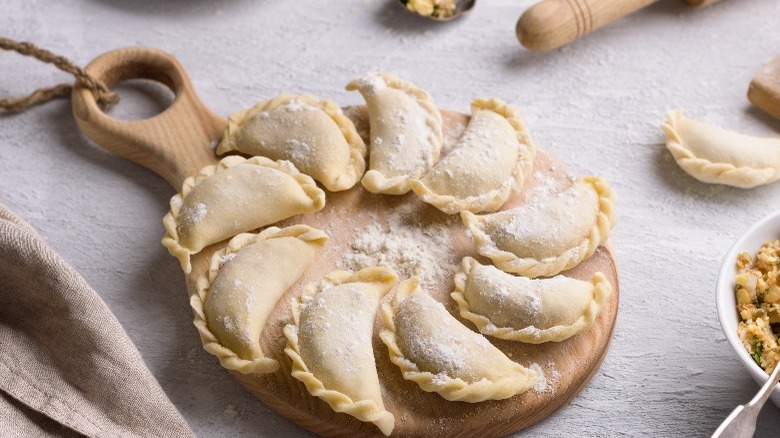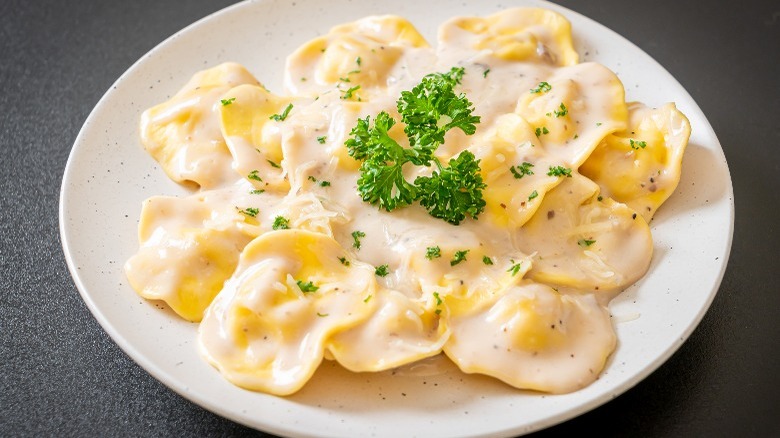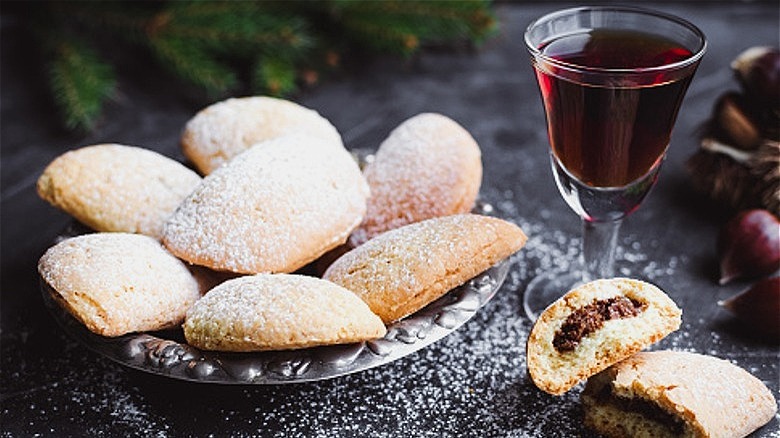14 Facts You Should Know About Ravioli
We may receive a commission on purchases made from links.
Ravioli come in all sorts of shapes and colors. These miniature pillows are one of the world's favorite pastas. However, anyone who researches the history of ravioli soon learns that the origins of this dish aren't completely clear. There is some documented evidence, but even these tales are peppered with speculation.
This pasta is made from flour, water, and eggs. Once formed into a dough, it's compressed into a large sheet. You'll usually see ravioli on Italian restaurant menus, prepared with marinara sauce, lobster sauce, broth, or other delicious ingredients. Ravioli can also be stuffed with meats, seafood, vegetables, and cheese — the possibilities are endless. You can also boil them, saute them, or fry them. There are even dessert ravioli. There are many options for preparing ravioli at home. You can make them fresh from scratch, buy frozen ravioli, purchase a packaged version, or even buy canned ravioli. But before you get started, here are 14 eye-opening facts about these beloved pasta pockets.
1. It goes by many names
Ravioli is the English version of the Italian word riavvolgere, which translates as "to wrap." Since the word for just one ravioli is raviolo, ravioli is the plural form. Never say "raviolis," especially when in Italy. If you do, you may face scrutiny from the locals.
To make things a bit more confusing, there are even more types of filled Italian pastas that you may get confused with ravioli. Each style comes with its own name. There is agnolotti, culurgioni, casoncelli, as well as other regional specialties that have tweaked the basic recipe for ravioli.
Tortellini is similar to ravioli, but after the pasta sheets are cut out and stuffed, they get folded over into curled shapes. Ravioli generally has more stuffing than tortellini, which can be more delicate to cook. On the other hand, tortellini dishes are usually smaller, so you'll also get a lot more of each pasta in a serving.
2. Similar Asian dishes likely came before it
Anyone who likes both dumplings and ravioli may have realized the two can have similar shapes. Dumplings, called jiaozi, are a classic food that was reportedly invented in China. While it's not certain that the raviolo is a direct descendant of the dumpling, the Chinese version of this filled food likely existed prior to the ravioli. Some sources say Chinese dumplings have been around since 200 B.C. According to the story, a physician named Zhang Zhongjing filled some dumplings with meat and spices, before serving them with some broth. This hearty dish was distributed to impoverished people, helping to fill them up.
In Iran, making similar stuffed dishes similar to ravioli has also long been a tradition. Then, there's also another type of Chinese steamed bun, called mantou, that's been around for a while. However, these buns do not contain a filling. While not exactly like the ravioli, these different shapes show how similar dishes exist worldwide.
3. We probably shouldn't thank Marco Polo for it
Marco Polo is much more than a swimming pool game. The legendary name initially belonged to a famous Italian explorer. During his travels, Polo traveled to see the Mongolian emperor Kublai Khan. After spending years in that part of the world, Polo returned to Venice, Italy, in 1295. This journey has led some to believe that Polo returned with foods that would go on to inspire pasta and ravioli, but there doesn't seem to be much evidence for this.
Other evidence shows that ravioli might have existed in southern Italy in the ninth century, which is hundreds of years before Polo's return. Some people think pasta began to take root in Italy when Arab populations invaded Sicily, bringing noodles from other countries with them.
In any case, the first Italian ravioli wasn't served with tomato sauce until hundreds of years later. Initially, it was not native to Europe. Some people also thought the red fruit was poisonous and were afraid to eat it. Instead, tomato plants were used as decorations. The earlier ravioli dishes were served with other ingredients. Soon enough, cooks started filling them up with regional foods and new recipes began to form.
4. By the 14th century, the dish was getting popular
Ravioli was becoming more of a commonplace Italian dish by the 14th century. Around this time, an Italian merchant named Francesco di Marco wrote about eating ravioli while living in Prato, a city located in the Italian region of Tuscany. In this text, the merchant describes eating ravioli with a combination of cheese, herbs, and an egg. Around the same time, there is evidence to suggest that King Richard II was also having chefs prepare him ravioli-like dishes, although the food likely went by a different name.
There is also a 14th-century manuscript called Libro per cuoco. This text discusses ravioli made in a few different ways, including a recipe for a meat and cheese version without the pasta wrapper. These may have been more like fried cheese balls or croquettes, but they were referred to as "rafioli."
5. There are several types of similar Italian filled pastas
There are several types of filled Italian pastas out there, similar to the classic ravioli shape. Some consider these pasta shapes to be types of ravioli, while others call them their own thing. You can prepare these filled pasta shapes in many different ways.
Italy's Piedmont region is known for making one such shape, called agnolotti. These pasta pieces are on the smaller side. During one agnolotti preparation, the pasta is simmered in a meat broth and topped with grated Parmigiano-Reggiano. Culurgioni is a type of Sardinian stuffed pasta that's similar to ravioli. In one recipe, this pasta shape is stuffed with ricotta, spinach, eggs, and saffron. It is formed to look like wheat stalks.
Casoncelli pasta has a more twisted shape, while pansotti is triangular — these two are common in Liguria. In Lombardy, casoncelli can be prepared with butter and sage. In other recipes, it's even filled with pumpkin and bits of amaretti biscotti. Scapolesi hails from Molise and is a more complicated dish, stuffed with ricotta and pecorino, ground meat, sausage, and chard; it's then boiled, covered in thick ragu, and baked to perfection.
6. It's not too difficult to make fresh
Making homemade ravioli is a labor of love and — although it's time-consuming — the process is not too complicated. The key is to work quickly. Once the pasta is ready to be filled, it can dry out quickly. It can take a few times to get it right. Certain equipment is also necessary.
Ravioli pasta dough is made from flour, eggs, and olive oil. It can be kneaded by hand, or using a food processor. While the dough is resting, the filling ingredients can be put together. Beginners can start with drained ricotta cheese, eggs, parmesan, and spices. Some food processors come with pasta roller attachments, or a manual one can be used. After the dough is rolled into long sheets (about 2 to 3 millimeters thick), the filling can be dolloped in small mounds onto the pasta. The first sheet gets covered with a second one, then pressed around the filling.
Once the filling balls are covered and sealed, squares or circles can be cut out around them with a knife or ravioli cutter. If you use the latter, you might get better-looking edges. The leftover scraps can be sliced into fettuccine. Fresh, homemade pasta always tastes best the same day it's made, so don't leave it in the fridge or sitting out. If you can't eat it all, your best choice is to freeze the ravioli, which prevents it from getting soggy or soft.
7. It floats
Ravioli is one of the more fun foods to eat, but it's kind of cool to boil, too. That's because the air inside it expands, allowing each of the ravioli to float. This usually happens within just a few minutes.
But don't pull them right out as soon they hit the surface, because they'll likely be undercooked. Frozen ravioli is a time-saver. It also comes with plenty of different fillings. These can usually be added right into simmering pasta sauce or broth. There's no need to thaw them. But unlike fresh ravioli, frozen ones can be dense, and will sink to the bottom of the pot much faster. Once they've boiled for a bit, this will change.
A few words of caution for boiling ravioli: Avoid boiling them on high heat because they tend to break apart. It's fine to lower them carefully into boiling water but immediately reduce the temperature. Also, don't leave them in there for too long, lest the filling should leak out. It shouldn't take more than a few minutes. But if you're unsure, just pull one out and try it.
8. Chef Boyardee's canned version goes way back
Nothing compares to freshly prepared pasta, but it has a short shelf life compared to the boxed version. Dried ravioli isn't as common, because of the fresh fillings inside. While frozen ravioli is convenient, it doesn't travel as well. Canned ravioli can traverse great distances, thus making them a perfect solution for some situations. This was first manufactured in World War I for soldiers, by companies like Buitoni and Heinz.
In the United States, the brand name Chef Boyardee is synonymous with canned ravioli. There was a real chef behind the idea, and his name was Hector Boiardi. His Pennsylvania plant operated around the clock to produce canned ravioli for World War II troops. He was awarded a Gold Star in 1946 for his efforts. That same year, he sold the company to American Home Foods for $6 million. It is now owned by Conagra Foods. Besides the basic cheese ravioli, there are beef and sausage flavors, plus spaghetti and meatballs, as well as lasagna.
9. It holds a Guinness World Record
The largest ravioli ever made, according to the Guinness World Records, was produced in Malta. The massive pasta parcel was made by the Tat-Taljan Company, in 2013. This company was a pasta manufacturer, which also makes tortelloni, cannelloni, sausage rolls, and pizza. Their record-breaking ravioli weighed just over 175 pounds. One can only imagine the size pot that was needed to cook it in. They may have also needed a crane to lift it out.
Not quite as impressive visually, but also in 2013, celebrity chef Jamie Oliver hosted chef Gennaro Contaldo's attempt to beat the Guinness World Record for the highest number of ravioli made in just two minutes. He just beat the previous record of 22, making 24. Another source claims that chef Gino D'Acampo made 33 in that amount of time on July 25, 2013, but this is not confirmed. However, the Guinness World Record for the longest ravioli was also that year, made by Amway in St. Petersburg, Russia. It was just over 96 feet long, and around 2 inches wide.
10. Toasted ravioli's origins are often debated
Toasted (or fried) ravioli's origins are often the subject of debate. Many people believe they were invented somewhere in St. Louis. There's an Italian American neighborhood there called The Hill, and a few restaurants there claim to have invented toasted ravioli. Some of these are Lombardo's, Charlie Gitto's, and Oldani's.
Like so many of the world's best discoveries, the first toasted ravioli was purportedly an accident that turned out to be an amazing thing. These restaurants assert that one or more ravioli were mistakenly dropped in hot oil instead of water. They looked too good to throw out so people just had to try them, with or without a dusting of parmesan. Louis Oldani is credited as coming up with the name "toasted" because he thought it sounded more palatable than "fried." His restaurant is now called Mama's on The Hill.
The storyline doesn't mention breading, so it's assumed here that it was added a little while later, to perfect the recipe. Toasted ravioli quickly caught on. Its combination of a crispy, savory fried outside and creamy inside is appealing and decadently delicious. Restaurants like Olive Garden serve it as appetizers, much like fried mozzarella sticks with a side of marinara sauce.
11. The pasta shape has some exciting relatives
It's already been established that ravioli has direct ties to Chinese dumplings, but other relatives are also part of this filled food family. First up is manti, a traditional Turkish dish that first appeared in the 13th century. It's a dumpling recipe that uses onions and ground meat for filling. Manti first made its way to Turkey from Central Asia and is now found in Armenian and Afghan cuisine, too. Then, there's empanadas. This Latin dish is often filled with meat and deep-fried.
Then there are Polish pierogies and Russian vareniki. Potato pierogi are amazing when sauteed with onions, vareniki go great with sour cream. Jewish kreplach is another type of dumpling also made with the same kind of simple flour-based dough, then filled with things like meat or onions. They can be served boiled, added to soup, baked, or fried. The traditional shape is triangular. They taste great served with ketchup or barbecue sauce, but are good enough on their own.
12. Vegetarian ravioli is more common than you may think
The traditional way to prepare ravioli in Italy is without meat, using vegetarian recipes. One of the best-loved versions has a filling of ricotta, spinach, and parmesan. This is sometimes called di magro, the Italian word for "lean." It's said that the name was coined by Catholics, to indicate that the ravioli didn't have any meat inside. This way, they knew it could be eaten on Fridays during Lent.
The habit took hold, and many Italians still eat ravioli di magro on Fridays. There are other ways to make it too. Vegetarian ravioli can also be made with pumpkin filling or plenty of other vegetables. It's also possible to make vegan ravioli by omitting the eggs from the dough and dairy from the recipe. The filling can be made from nuts, lemon juice, water, spices, plus cornstarch to hold it all together.
13. Ravioli's nutritional information can vary
It isn't easy to determine ravioli's nutritional value, with so many ravioli recipes — plus different soup and sauce — options out there. To get a general idea, one can consider a serving of seven large cheese ravioli. According to Nutrionix, this has 14 grams of fat, 551 milligrams of sodium, and 42 grams of carbs. It also has 19 grams of protein, 2 grams of fiber, and 1 gram of sugar. Plain cheese ravioli isn't that exciting, so most people add on things like sauce. That's where more sugar often comes in.
For comparison's sake, a serving of a can of Chef Boyardee Cheese Ravioli with Tomato Sauce (via Walmart) has 2 grams of fat, 600 milligrams of sodium, and 40 grams of carbs. It also has 7 grams of protein, 4 grams of fiber, and 9 grams of sugar. It's made with water, flour, tomatoes, cheddar, romano cheese, corn syrup, spices, and much more.
14. Dessert ravioli is a thing
In India, natives make crescent-shaped gujiya and karanji, half-moon-shaped fried pasta with sweet fillings. These sweet and more distant ravioli cousins are made for festivals, filled with khoya and nuts, and baked or fried. Karanji is similar but usually filled with coconut, sesame seeds, and poppy seeds.
This idea is not a new one. Up until the 16th century, pasta was usually prepared or served with things like marmalade, currants, and cinnamon. While many people will only eat ravioli with red or white sauce, dessert ravioli is trending. The dough can have vanilla and chocolate in it, and the fillings can include fruit, nuts, peanut butter, and of course, even more chocolate. Italian sweet ravioli, or ravioli dolce, is one of the best-known dessert ravioli and is also served during Lent. They're filled with sweet centers, fried, and dusted with powdered sugar. Either way, it's delicious.
